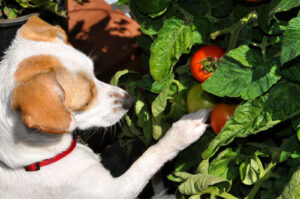Posts Tagged ‘toxic plants for dogs’
Is This Plant Toxic to Dogs? Complete List of Plants Your Dog Should Avoid
 There are plenty of risks to your dog daily. Whether it be cars, other dogs, or something as simple as a plant, it is vital to know the risks that can affect your dog.
There are plenty of risks to your dog daily. Whether it be cars, other dogs, or something as simple as a plant, it is vital to know the risks that can affect your dog.
The most common poisonous plant to dogs is the Sago Palm. This plant is very popular in warmer climates. Every part of this plant is toxic to dogs. This plant is extra dangerous because some dogs find them very delicious and are very attracted to them. The serious side effects of this plant include liver failure and death in some cases.
Another common plant that is toxic to dogs is the tomato plant. When dogs consume this, it can cause weakness, gastrointestinal problems, dilated pupils, slow heart rate, drowsiness, and confusion. Make sure your dog steers clear of this plant to avoid any unnecessary vet visits.
Aloe vera is another summertime plant that is toxic to dogs. The saponins in this succulent can cause vomiting, diarrhea, lethargy, tremors, and general nervous system depression.
Ivy is also quite toxic to dogs, having the capability of causing diarrhea, vomiting, excessive salivation and drooling, and abdominal pain.
The amaryllis bulb is a popular garden ornamental but is poisonous to dogs. Be sure to pay attention to the bulbs if you grow them inside. Similarly, the gladiola flower can cause drooling, vomiting, diarrhea, and lethargy when consumed.
The holly shrub is a low toxicity plant, but your dog could still experience vomiting and diarrhea if eaten.
The daffodil, commonly found in the spring, can cause intestinal spasms, low blood pressure, salivation, tremors, vomiting, diarrhea, and even cardiac arrhythmia if eaten by your dog.
Common in every flower arrangement is the baby’s breath flower. When eaten, this small flower can cause vomiting and diarrhea.
Used to attract butterflies, milkweed is very common and pleasant to look at. However, this flower will induce vomiting and diarrhea, difficulty breathing, rapid and weak pulse, dilated pupils, and even more serious issues such as kidney or liver failure and death.
Common in parks and other large-scale landscaping, the castor bean can cause drooling, vomiting, diarrhea, extreme thirst, loss of appetite, and abdominal pain. It is potentially fatal in severe cases which may present as muscle twitching, tremors, seizures, and even coma.
The azalea or rhododendron flower is poisonous to dogs and produces serious gastrointestinal issues. Additionally, it can cause weakness, discoordination, and weak heart rate. This flower has the potential to be fatal.
Next, the tulip is very popular for gardens but can cause gastrointestinal issues as well as central nervous system depression and even convulsions and death.
Similarly, the chrysanthemum flower can cause vomiting, diarrhea, skin rash, and drooling for your dog if they consume it.
Lastly, the begonia is an extremely common garden flower that is toxic to your dog. It can cause extreme oral irritation and excessive inflammation of the mouth and drooling and vomiting.
Summertime is the time to be outdoors, but that means an increased risk for your pet to accidentally consume something poisonous to them. Be sure to keep an eye on your dog and monitor what they try to eat. If you have any questions or concerns about your pet has, or may have, eaten, contact us today!
